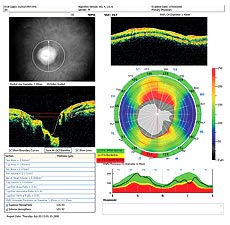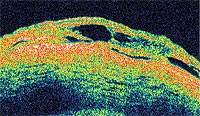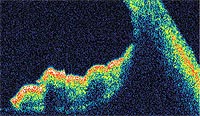Uses of OCT imaging reach beyond AMD
Click Here to Manage Email Alerts
Optical coherence tomography (OCT) is well known as a tool for identifying and imaging retinal edema. However, according to three practitioners who spoke to Primary Care Optometry News, the device is useful for managing glaucoma, diabetic retinopathy and some anterior segment diseases as well.
Anterior segment – analyzing angle, corneal defects
PCON Editorial Board member J. James Thimons, OD, has learned to use his time domain OCT device in an adaptive way to image the anterior segment.
“The OCT was originally designed to be a posterior segment instrument, but because of its remarkable dexterity, you can actually modify the system for analysis by moving into the very high plus range,” Dr. Thimons said in an interview. “I can image the anterior chamber angle effectively to determine narrowness. It is basically a high-resolution gonioscopy. I can also image corneal defects. I can look at relative depth and get a good idea of how deep a scar is or where it is relative to the rest of the normal cornea.”
 The Optovue NMH4 printout (from a spectral domain OCT) also shows a small focal loss at the rim (seen in red in the IT1 sector) as well as focal loss on the TSNIT curve. Image: Fingeret M |
Dr. Thimons said he uses the 3 mm and 5 mm in real time to observe and capture his basic image and scans line.
“The longer the line, the more of an arc the image becomes,” he advised. “It actually distorts the corneal anatomy, so you want to use a shorter line to get a cleaner view. The beauty is that I can also angulate that line by manipulating the drop-down screen on the instrument to create any angle of approach I want.”
He also uses the instrument to look at the internal anatomy of filtering blebs from the outside, as well as iris cysts.
“Some patients come in with an iris cyst and you will want to know whether it’s a cyst or a melanoma,” Dr. Thimons said. “This is a clear way to accomplish that because it shows very nicely the anatomy in the visual plane of the lesion, behind it and also the posterior iris pigment. You get a nice idea of what’s going on and you can track it.”
 |  |
| An OCT is used to evaluate the anatomy of a filtering bleb. Images: Thimons JJ | |
 This anterior chamber angle is viewed in a pigment dispersion patient. |  This anterior chamber angle is viewed in a low hyperope. |
Dr. Thimons said he also uses his OCT to image the conjunctiva.
“If a patient has a conjunctival cyst and you’re thinking about lancing it, you can actually image across the body of the cyst,” he said. “You just move the scanning beam back and forth and, as you do that, you can actually see whether it is single chamber or multilobulated. Before I do a procedure on it, or if I want to do a lid lesion, I want to see what is in the lesion.”
The instrument images keratoconus well, he added, and can show how dense the scar on a cone might be.
Diabetic retinopathy – evaluating macular thickness
Anthony Cavallerano, OD, FAAO, a PCON Editorial Board member who practices at VA Boston Health Care System, said he also considers his OCT instrument useful beyond its original capacity.
“It is valuable for conditions that cause any change in the architecture and structure of the retina – in particular the macula – including edema, thickening of the retina, neurosensory retinal elevation such as central serous choroidopathy and pigment epithelial detachments,” he said. “It is also a great tool, probably the best, for evaluating vitreomacular interaction in conditions such as epiretinal membrane, vitreomacular traction syndrome and macular hole formation.”
Dr. Cavallerano spoke to PCON about the uses of the instrument for his diabetic retinopathy patients, in particular.
The tool, he said, allows practitioners to obtain a precise macular thickness dimension in patients who are suspected of having macular edema. It also has reduced the need for having patients undergo an invasive fluorescein angiography (FA) procedure.
“The OCT also allows us to analyze the various layers of the retina for thickening, with the ability to track change over time for the diabetic patient,” Dr. Cavallerano said. “If change is detected using OCT, then it may warrant a FA to determine suitability for treatment.”
Glaucoma – measuring nerve fiber layer
The OCT is useful in diagnosing glaucoma patients because it measures the retinal nerve fiber layer thickness, Murray Fingeret, OD, chief of the optometry section at the Department of Veterans’ Affairs Medical Center in Brooklyn and Saint Albans, N.Y., and a professor at SUNY College of Optometry, told PCON in an interview. He also uses the OCT to evaluate the optic disc by measuring the rim size and disc area.
Dr. Fingeret, also a PCON Editorial Board member, said he is waiting to see whether the newer spectral domain OCT instruments will be able to image the macula for glaucoma, a controversial subject.
“The question of whether early glaucomatous damage occurs in the macular region has been studied,” Dr. Fingeret said. “The older OCTs did not show that imaging the macula was helpful diagnostically.”
“This question is being revisited with the newer spectral domain OCTs that provide far better resolution,” Dr. Fingeret said. “The reason people have always looked at imaging the macula for glaucoma is that the number of nerve fibers in the macular region is more consistent person to person.”
Dr. Fingeret added that the nerve fiber layer scan remains the standard technology for glaucoma.
Billing: 92135
Practitioners can bill for most OCT images using the 92135 code, Dr. Cavallerano said.
While some of the anterior segment images may not be billable, Dr. Thimons said that does not stop him from using the device for that purpose. “Even if you can’t bill for it, it is just good care for the patient and it gives the doctor a lot more information,” he said.
“A revolution”
Dr. Cavallerano said the OCT has revolutionized the way practitioners understand the biology of retinal diseases. That means most primary care practitioners probably will want to understand and adopt the technology, he said.
“The OCT and other diagnostic imaging technologies, once thought to be the purview of specialty and subspecialty care, have really become a staple in primary care environments,” Dr. Cavallerano said. “We will find that more and more primary care optometrists and ophthalmologists will be resorting to technology, including the OCT, for enhanced diagnostic capability, for ongoing monitoring of patients with macular disease and in managing and comanaging patients.”
For more information
- J. James Thimons, OD, can be reached at Ophthalmic Consultants of Connecticut, 75 Kings Highway Cutoff, Fairfield, CT 06430; (203) 257-7336; fax: (203) 330-4958; e-mail: jthimons@sbcglobal.net.
- Anthony Cavallerano, OD, FAAO, can be reached at 150 S. Huntington Ave., Boston, MA 02130; (857) 364-2281; fax: (857) 364-6538; e-mail: tonycav@earthlink.net.
- Murray Fingeret, OD, may be contacted at St. Albans VA Hospital, Linden Blvd. and 179th St., St. Albans, NY 11425; (718) 298-8498; fax: (516) 569-3566; e-mail: murrayf@optonline.net.
